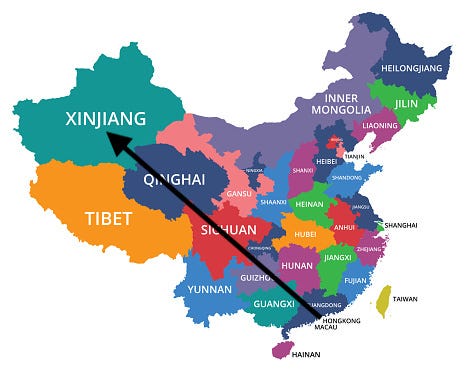Xinjiang, a region in the northwest of China, has been in the news a lot lately. Last week, the UK Parliament joined the United States in accusing China of crimes against humanity for its treatment of the Uyghur minority group in Xinjiang. This follows an uproar against companies that may be taking advantage of forced labor by doing business with suppliers in Xinjiang.
Here’s another piece of interesting news about Xinjiang that you might have missed if you’re not paying attention to crypto... Disruptions at coal mines in Xinjiang recently took down a significant chunk of the computing power that supports Bitcoin.
What’s going on here? Why are so many supply chains — both physical and digital — ending up in Xinjiang?
The easy answer is money. Labor is cheap in Xinjiang, and energy is cheap in Xinjiang.
But, more fundamentally, we’re seeing what happens when buyers are optimizing for financial costs — and ONLY financial costs. Xinjiang labor is cheap, if you don’t consider the human cost. Xinjiang energy is cheap, if you don’t consider the environmental cost of carbon emissions — or the terrible cost to human health associated with coal-fired plants.
Personally, I think we’re at the end of this era, the era of focusing exclusively on financial costs. Why? Because I think corporate consideration of non-financial costs is correlated with consumer awareness of non-financial costs. And, thanks to technology as well as the efforts of activists, consumer awareness of non-financial costs is growing.
I saw this story unfold once before, in the context of physical supply chains, when I led Panjiva. Panjiva (now part of S&P Global) crunched data in order to make visible the activities of millions of companies that were doing business across borders. A quick trip down memory lane…
When China joined the WTO in 2001, it became possible for global companies to access a huge mainland China labor force that had few alternatives and was therefore willing to work for low wages. China complemented cheap labor with strong infrastructure and export-friendly policies. As a result, China became the go-to location for companies looking to manufacture at low costs.
As more and more companies moved into China, wages started to rise. Executives began talking about moving beyond manufacturing’s first home in China — cities in and around the Pearl River Delta — to regions further inland where wages were lower. It’s taken twenty years, but this particular trend has run its course. Take a look at a map of China, and you’ll see that Xinjiang is as inland as it gets.
Capitalism did its thing in raising standards of living. But, interestingly, market forces didn’t drive political changes, as many expected. It turns out that the search for profit doesn’t inevitably lead to democracy. Nor, by the way, will the search for profit inevitably lead Bitcoin miners to transition to renewables.
Meanwhile, during this time, Panjiva began its effort to bring transparency to global supply chains. We leveraged machine learning to make sense of huge amounts of data, and the end result was a remarkably clear view of where global companies were manufacturing their products. Data about labor conditions and environmental practices of factories was still scarce. But, thanks to Panjiva and its competitors, it was now easier than ever to connect brands to the factories they were using. When factory abuses came to light, brands that were working with those factories were exposed and typically took swift action.
It’s kind of crazy to think that digital supply chains are currently more opaque than physical supply chains. But here we are. We know which garments are manufactured in Xinjiang, but we don’t know which Bitcoins are mined there. In fact, until a coal mine was flooded, we didn’t even know just how much of the world’s Bitcoin mining activity was located in Xinjiang.
Certainly many Bitcoin proponents view this as a feature, not a bug, of the world’s most popular cryptocurrency. A distributed network of miners, motivated by money, are cooperating to mine Bitcoin and keep it secure — no trust, or transparency about mining methods, required! What results is a fungible token. A Bitcoin is a Bitcoin is a Bitcoin, no matter how much carbon is emitted during the mining process.
Can the crypto supply chain be as transparent as a physical supply chain, without undermining the essence of crypto? Personally, I think the answer is yes. In fact, I think the answer needs to be yes, if crypto is going to thrive. Consumer awareness of the non-financial costs of crypto is growing. Corporate and governmental consideration of these costs won’t be far behind.
Climate change is top-of-mind for a lot of people. Increasingly, products that contribute to the problem will be disadvantaged in the marketplace relative to products that don’t. This will be true of physical products, and it will be true of digital products. And, yes, I’m willing to bet it will even be true of cryptocurrencies.





Agreed that we need to find ways to make PoW crypto (mainly Bitcoin) more climate friendly. But another key goal for Bitcoin is fungibility which seems inconsistent with tracking the provenance of each coin. Sure, PoS doesn't have the same climate problem but it is likely to end up being much more centralized because there is no natural way to dilute the holders/stakers. Seems to me that market forces to drive down the price of renewables is the only viable option. If we can encourage / speed up those market forces, even better.